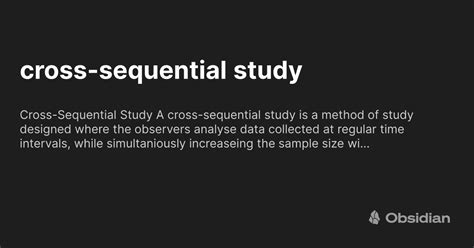What Is Cross Sequential Research

Cross sequential research is a sophisticated methodology that combines the strengths of both cross-sectional and longitudinal research designs to study the dynamics of developmental processes and phenomena over time. This innovative approach enables researchers to examine the complex interactions between different factors, track changes, and identify patterns that might not be apparent through other research methods.
Introduction to Cross-Sequential Research
To grasp the essence of cross sequential research, it’s essential to understand its foundational components: cross-sectional and longitudinal studies. Cross-sectional research involves observing a defined population at a single point in time, providing a snapshot of the variables of interest. Longitudinal research, on the other hand, follows the same subjects over a period, allowing for the observation of developments and changes in the variables under study.
Cross sequential research bridges these two methods by incorporating elements of both. It involves recruiting participants of different ages (or cohorts) at the outset and then following them over time. This design allows researchers to study age-related changes without having to wait for an extended period, as would be necessary in a traditional longitudinal study starting with a single cohort.
How Cross Sequential Research Works
The process of conducting cross sequential research can be complex, but it essentially involves the following steps:
Selection of Cohorts: Researchers select multiple cohorts based on different age groups. For example, if the focus is on the development of adolescents, the cohorts might include 12-year-olds, 15-year-olds, and 18-year-olds.
Initial Data Collection: Baseline data are collected from all cohorts at the beginning of the study. This initial phase provides a cross-sectional view of the variables of interest across different age groups.
Follow-Up: Each cohort is then followed over time, with data collected at regular intervals. The duration between data collection points can vary depending on the research question and the pace of development in the area of interest.
Analysis: The data collected over time are analyzed to identify patterns of change, stability, or differences among the cohorts. This analysis allows researchers to distinguish between age effects (changes due to aging), cohort effects (differences due to being part of a specific generation), and period effects (influences due to the time of measurement).
Advantages of Cross Sequential Research
Cross sequential research offers several advantages over traditional longitudinal and cross-sectional designs:
- Efficiency: It allows researchers to study developmental processes over a significant period without having to wait for decades for a single cohort to mature.
- Comprehensive Understanding: By combining cross-sectional and longitudinal data, researchers can gain insights into both the current state of a phenomenon and how it evolves over time.
- Control for Cohort Effects: The design enables the separation of age effects from cohort effects, providing a clearer understanding of developmental changes.
Challenges and Limitations
Despite its advantages, cross sequential research also poses challenges, including:
- Complexity in Analysis: Distinguishing between age, cohort, and period effects can be statistically complex and requires sophisticated analytical techniques.
- okres: The duration of the study can still be lengthy, especially if the phenomenon of interest develops slowly.
- Sample Representation: Ensuring that the cohorts are representative of the broader population and that sample attrition does not bias the results is crucial.
Applications of Cross Sequential Research
Cross sequential research has been applied in various fields, including psychology, sociology, education, and public health, to study topics such as:
- Cognitive development across the lifespan
- The impact of changing social policies on different generations
- Educational outcomes and achievement over time
- Health behaviors and disease prevalence in various age groups
Conclusion
Cross sequential research is a powerful tool for understanding developmental processes and changes over time. By leveraging the benefits of both cross-sectional and longitudinal designs, it offers a nuanced view of how factors interact and influence outcomes across different age groups. As research methodologies continue to evolve, the application of cross sequential research is likely to expand, providing deeper insights into complex phenomena and guiding evidence-based practices and policies.
FAQ Section

What is the primary advantage of cross sequential research over traditional longitudinal studies?
+The primary advantage is its efficiency, as it allows researchers to study developmental processes over a significant period without having to wait for decades for a single cohort to mature.
How does cross sequential research control for cohort effects?
+It controls for cohort effects by including multiple cohorts and analyzing the data to distinguish between age effects, cohort effects, and period effects.
What are some common applications of cross sequential research?
+Applications include studying cognitive development, the impact of social policies on different generations, educational outcomes, and health behaviors over time.

